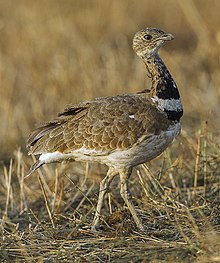Little bustard
| Little bustard | |
|---|---|

| |
| Male | |

| |
| Female | |
| Scientific classification | |
| Domain: | Eukaryota |
| Kingdom: | Animalia |
| Phylum: | Chordata |
| Class: | Aves |
| Order: | Otidiformes |
| Family: | Otididae |
| Genus: | Tetrax T. Forster, 1817 |
| Species: | T. tetrax
|
| Binomial name | |
| Tetrax tetrax | |

| |
| Range of T. tetrax Breeding Resident Non-breeding Passage Probably extinct Extinct
| |
| Synonyms | |
|
Otis tetrax Linnaeus, 1758 | |
The little bustard (Tetrax tetrax) is a
Distribution
It breeds in
Description
Although the smallest

The female and non-breeding male lack the dramatic neck pattern, and the female is marked darker below than the male. Immature bustards resemble females. Both sexes are usually silent, although the male has a distinctive "raspberry-blowing" call: prrt.
Diet
This species is
Breeding
Like other bustards, the male little bustard has a flamboyant display with foot stamping and leaping in the air. Females lay 3 to 5 eggs on the ground.
Habitat
The bird's habitat is open grassland and undisturbed cultivation, with plants tall enough for cover. Males and females do not differ markedly in habitat selection.[7] It has a stately slow walk, and tends to run when disturbed rather than fly. It is gregarious, especially in winter.
Tracking of male Little Bustards has revealed that they are nocturnal migrants that make frequent stopovers in non-irrigated and irrigated croplands to reach more productive agricultural post-breeding areas. [8]
References
- . Retrieved 11 November 2021.
- ^ "Appendices | CITES". cites.org. Retrieved 14 January 2022.
- ISBN 978-1-4081-2501-4.
- .
- ^ "Little Bustard Shot". cyprusbirdingtours.com. 17 December 2013. Retrieved 15 March 2014.
- ^ "BTO BirdFacts: Little Bustard". British Trust for Ornithology. Retrieved 13 January 2018.
- S2CID 54035952.
- hdl:10451/46413.
External links
- Oiseaux.net Little bustard photos
- "Little bustard media". Internet Bird Collection.
- Little bustard photo gallery at VIREO (Drexel University)
- Interactive range map of Tetrax tetrax at IUCN Red List maps
- BirdLife species factsheet for Tetrax tetrax
- "Tetrax tetrax". Avibase.
- Audio recordings of Little bustard on Xeno-canto.

